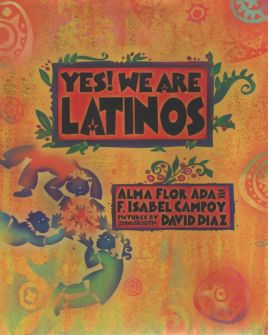Yes! We Are Latinos
Si! Somos Latinos
Juanita lives in New York and is Mexican. Felipe lives in Chicago and is Panamanian, Venezuelan, and black. Michiko lives in Los Angeles and is Peruvian and Japanese. Each of them is also Latino.
Thirteen young Latinos and Latinas living in the United States are introduced in this book celebrating the rich diversity of the Latino and Latina experience. Free-verse fictional narratives from the perspective of each youth provide specific stories and circumstances for the reader to better understand the Latino people’s quest for identity. Each profile is followed by nonfiction prose that further clarifies the character’s background and history, touching upon important events in the history of the Latino American people, such as the Spanish Civil War, immigration to the US, and the internment of Latinos with Japanese ancestry during World War II.
Alma Flor Ada and F. Isabel Campoy’s informational yet heartwarming text provides a resource for young Latino readers to see themselves, while also encouraging non-Latino children to understand the breadth and depth of the contributions made by Latinos in the US. Caldecott Medalist David Diaz’s hand-cut illustrations are bold and striking, perfectly complementing the vibrant stories in the book.
YES! WE ARE LATINOS stands alone in its presentation of the broad spectrum of Latino culture and will appeal to readers of fiction and nonfiction.
Editorial Reviews
From School Library Journal
Gr 4-8–A collection of narrative poems meant to represent young Latinos of diverse and multiple backgrounds. All of the selections start with the statement, “My name is…,” followed by a bit about where the narrators live, how they came to the United States, and how their families’ cultural identities are shaping their future. Each entry is followed with another short narrative that includes historical references to contextualize the “child’s” story. It is refreshing to see a varied presentation that includes those from different ethnic, racial, and religious backgrounds, in addition to representing some of the smaller Latin American countries and the islands in the Caribbean. The vignettes also help to illustrate the meaning of being mestizo–the blending of indigenous, African, and Spanish lineage–mentioned in the introduction and explored throughout. Another notable detail is the inclusion of Asians in Latin America, which is often overlooked in children’s literature.
The illustrations are interesting lino cutouts, black and white, reminiscent of Latino folk art, akin to wood carvings and papel picado. Teachers looking for a starting point to write personal narratives will find the book extremely useful as will those seeking to recognize and highlight this diverse population. A short list of Latino-inspired literature is appended.–Maricela Leon-Barrera, San Francisco Public Libraryα(c) Copyright 2013. Library Journals LLC, a wholly owned subsidiary of Media Source, Inc. No redistribution permitted.
From Booklist
This book celebrates the amazing and underappreciated diversity of the Latino community and makes great strides toward ameliorating one-dimensional stereotypes. Through 12 narrative poems, the authors explore the experiences of fictional men and women; Christians and Jews; immigrants, indigenous people, and second-generation Americans; professionals and farmers; all of whom identify themselves as Latinos. Each poem is followed by brief factual explanation of the major themes within, such as the Spanish Civil War, Asian influences in Latin America, and Cuba’s relationship with the U.S.
Black-and-white abstract art by Caldecott winner Díaz elevates each individual’s story by illustrating major themes. While the authors include a bibliography of source material, they also acknowledge a lengthy list of people who provided inspiration for the topics discussed in the book. Perhaps it is the use of these real-life figures that gives the fictional vignettes such an air of realism and relatability for both Latino and non-Latino readers alike. Grades 3-6. –Erin Anderson
Kirkus Review
A poetic celebration of the diversity found among Latinos.
Each poem in this collection of 13 vignettes is a glimpse into the life of a Latino child living in the United States. Ada and Campoy do a commendable job of creating a nuanced, realistic reflection of the many-faceted Latino experience, including characters from a variety of ethnic, religious, language and racial backgrounds. […] An informational piece follows each poem that […] expands on the social and historical context with honesty and depth. […] Díaz’s signature black-and-white cut-paper art decorates the collection and is especially noteworthy in its reflection of the themes in the informational pieces.[…] a collection both interesting and educational, offering Latino children positive representations of themselves and teaching non-Latino children about the richness and breadth of the Latino experience.
Goodreads [Kathy]
This book is a combination of fictional vignettes and non fiction descriptions of the many diverse Latino groups in the United States. The fictional sections are actually narrative poems about children/students living in different parts of the country with different heritages. The emphasis is on adapting to a new way of life and also retaining their native culture, language and customs. Depicted are the difficulties of coping with intolerant or ignorant people. The non fiction sections explore the history of each group and the contributions to art or music or literature or science that people of that culture have made.
Written by well respected and award winning authors; Alma Flora Ada and F. Isabel Campoy, the book is well researched . Block print illustrations are by David Diaz . They are an excellent addition to the narrative sections.
This book will be a welcome addition to school libraries on all levels as a resource and as an excellent way to educate students on the diverse backgrounds their fellow Latina/Latino classmates bring to a classroom. A great resource for teachers wanting to assign Latino/Hispanic figures for multicultural reports or a study of the various countries that make up Latin America.


